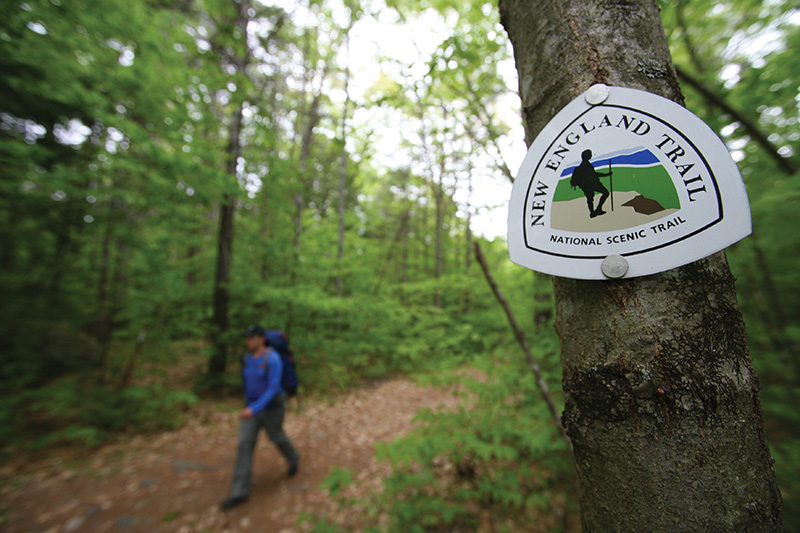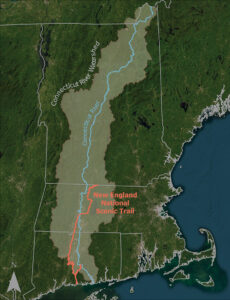 This article appears in the Summer 2024 issue
This article appears in the Summer 2024 issue

The New England National Scenic Trail
By Miriam Maistelman
The New England National Scenic Trail (NET), a 235-mile-long hiking trail stretching from Long Island Sound in Connecticut to the New Hampshire-Massachusetts border, is a close-to-home trail for millions of New Englanders. Designated by Congress as a National Scenic Trail in 2009, the NET guides hikers through state forests, wetlands, wildlife refuges, and up and down the formidable and humbling Holyoke and Mount Tom mountain ranges in Massachusetts. The Appalachian Mountain Club (AMC), the nation’s oldest conservation and outdoor recreation organization, maintains primary responsibility for managing the trail in Massachusetts in direct partnership with the National Park Service (NPS). The Connecticut Forest and Parks Association (CFPA) manages the Connecticut portion of the trail.

Image credit: Appalachian Mountain Club.
In December 2023, the New England Trail was officially designated a “unit” of the National Park System. This hard-won designation came in response to a decades-long legislative push led by AMC, CFPA, North Country Trail Association, and Ice Age Trail Alliance. This legislative feat, however, has been widely misinterpreted, resulting in many having the incorrect impression that the NET is a new national park. Unit status does not change public access to the trail or how it is managed on the ground but is effectively an internal administrative change. Nevertheless, this designation will open new opportunities for land managers to expand our capacity to protect the NET and serve the communities through which it travels.
Long before the New England Trail was even an idea, these lands were sustained, protected, and lived on by vast populations of indigenous tribes and communities: the Woronoco, Agawam, Nonotuck, Pocumtuck, Nipmuc, Abenaki, Tunxis, Wangunk, Quinnipiac, and Massacoe Nations. The contemporary approach to conservation, however, is missing a vital piece: an approach that worked for the thousands of years before nonprofit organizations were around, when conservation and stewardship were synonymous with living.
That’s why AMC and CFPA have partnered with Jay Levy, a tribal consultant indigenous to Colombia, to research and develop an Indigenous Site Survey of the NET. Through this multi-year project, Jay has surfaced research, oral history, and traditional knowledge about environmental stewardship, and translated this information into written reports and interactive maps for all NET visitors to enjoy. By working collaboratively with indigenous communities, AMC, CFPA, and Jay are laying the groundwork for a revitalized approach to conservation.

River view from the NET, Connecticut. Image credit: Ryan Smith, Appalachian Mountain Club
In November 2023, Jay presented at the Mashantucket Pequot Museum in Mashantucket, Connecticut, where his good friend, Josh Carter (Pequot-Narragansett), is the executive director. In collaboration with the museum, Jay and Josh have been hosting interpretive hikes along the NET called the Wuyâmu Series, Wuyâmu meaning “to be well” in Pequot. During these hikes, Jay and Josh tell the stories of the lands, peoples, and cultures.
The full report is expected to be completed by summer 2024 and will be made available on the NET’s website (newenglandtrail.org) along with the story maps currently on the site. Moving forward, we are pursuing potential funding for the continuation of this collaborative effort to support tribal youth hikes, trail crews, interpretive signage, videography opportunities, land-back projects, a series of indigenous historical guidebooks, and so much more.

Map of the New England Trail. Image credit: Megan Gordon, Mass Audubon
Situated within ten miles of two million people, the NET has the tremendous capacity to connect urban communities to recreational green spaces. There are, however, various systemic barriers that discourage residents from venturing out and exploring the green spaces in their backyards. To address these limitations, AMC has taken on a Transit-to-Trails Campaign in Holyoke, Massachusetts, to improve the connectivity between people and place. The Pioneer Valley Transit Authority (PVTA) has several bus routes that drive right past trailheads, while others routinely stop at NET access points.
Many people aren’t aware of the New England Trail, and there is a shortage of information, so AMC is working to develop informational signs to install at high-use bus stops and trailheads. Written in both English and Spanish, these signs will provide a description of the NET, offer hiking routes for people with ranging abilities, advise on bus lines, and inform hikers about supplies to carry as they head out onto the trails. We are also coordinating a series of hikes with local organizations to get Holyoke area residents onto the NET.
The NET offers residents of and visitors to the Connecticut River watershed alike opportunities to learn and experience this landscape in new ways. Improving access, diversifying management, and deepening our understanding of the trail in our backyards is a way to ensure connection with each other and this place.
This issue’s Conte Corner is guest written by Miriam Maistelman, New England Trail Coordinator for the Appalachian Mountain Club.
